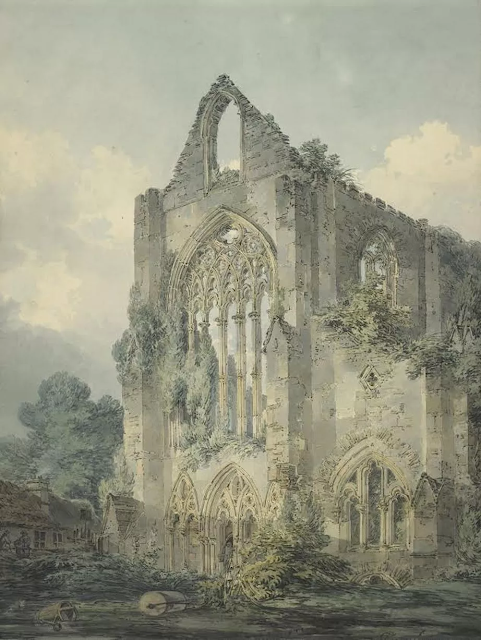 |
| Tintern Abbey |
Tears, Idle Tears
Tears, idle tears, I know not what they mean,
Tears from the depth of some divine despair
Rise in the heart, and gather to the eyes,
In looking on the happy autumn-fields,
And thinking of the days that are no more.
Fresh as the first beam glittering on a sail,
That brings our friends up from the underworld,
Sad as the last which reddens over one
That sinks with all we love below the verge;
So sad, so fresh, the days that are no more.
Ah, sad and strange as in dark summer dawns
The earliest pipe of half-awakened birds
To dying ears, when unto dying eyes
The casement slowly grows a glimmering square;
So sad, so strange, the days that are no more.
Dear as remembered kisses after death,
And sweet as those by hopeless fancy feigned
On lips that are for others; deep as love,
Deep as first love, and wild with all regret;
Poetical Tintern
“Descriptions of Tintern Abbey should be written on ivy leaves, and with a poet’s pen, for no other do justice to the air of solemn grandeur and religious melancholy reigning within its delicate cloisters”— Catherine Sinclair, Hill and Valley, 1838
Tintern Abbey was as much a magnet for poets as for professional and amateur visual artists in the period. The most famous literary work associated with the site is William Wordsworth’s Lines Written a Few Miles Above Tintern Abbey, on Revisiting the Banks of the Wye During a Tour, July,13, 1798. But it is interesting to note that there was large body of verse on the subject of the Abbey and topographical poems on the region well before the end of the eighteenth century. Syned Davies’ 1745 “A Voyage to Tintern Abbey, in Monmouthshire, from Whitminster in Gloucestershire” is the earliest represented here. The selection of authors and verses gathered here represents a small fraction of the surviving poetical descriptions, effusions and reflections inspired by the ruins. Those anthologized by Charles Heath in his Historical and Descriptive Account of the Ancient and Present State of Tintern Abbey, a guide sold locally at the Beaufort Arms, were carried into the Abbey itself, and perhaps read there.
- “A Voyage to Tintern Abbey”
- An Elegy Written Among the Ruins of an Abbey
- Mr. Gray
- The Poems of Mr. Gray, To Which are Prefixed Memoirs of his Life and Writings
- “Moonlight”
- “Poetical Description of Tintern Abbey”
- Excerpt from “Elegy on a Pile of Ruins”
- Excerpt from “The English Garden: A Poem”
- “Original Sonnet Composed on Leaving Tintern Abbey”
- The Banks of the Wye : A Poem. In Four Books
- P. Vandyke, Samuel Taylor Coleridge
- Early Recollections, Chiefly Relating to the late Samuel Taylor Coleridge
- “Lines, Written a Few Miles Above Tintern Abbey”
- Lyrical Ballads, with Other Poems: In Two Volumes
- Lyrical Ballads, with Other Poems: In Two Volumes
- “Monmouthshire”
- Rev. Dr. Sneyd Davies: Wrote "Epistle IV" in 1745, which describes his voyage to Tintern Abbey from Whitminster
- Rev. Duncomb Davis: Wrote a "Poetical description of Tintern Abbey" around 1790
- Edmund Gardner: Wrote a "Sonnet written in Tintern Abbey" in the 1790s
- Edward Jerningham: Wrote "Tintern Abbey" around 1800
- Rev. Luke Booker: Wrote an "Original sonnet composed on leaving Tintern Abbey"
- John Cunningham: Wrote "Elegy on a Pile of Ruins", which was published in 1761
- William Mason: Wrote an excerpt from "The English Garden: A Poem"
- Alfred Lord Tennyson: Wrote "Tears, Idle Tears"
- Allen Ginsberg: Wrote "Wales Visitation"
- Matthew Arnold: Wrote "The Buried Life"
 |
| Tintern Abbey by Benjamin Williams Leader |
 |
| Tintern Abbey: The Crossing and Chancel, Looking towards the East Window 1794, Joseph Mallord William Turner |
 |
| Edward Dayes, Tintern Abbey & the River Wye, 1794, Whitworth Art Gallery, The University of Manchester |
 |
| Tintern Abbey, oil painting by William Havell, Ashmolean Museum, University of Oxford |
 |
| Painting by Benjamin Williams Leader, 1883 |
 |
| Tintern Abbey with all of the foliage removed by the government |
 |
| Tintern Abbey |
 |
| Tintern Abbey |
 |
| Tintern Abbey |




